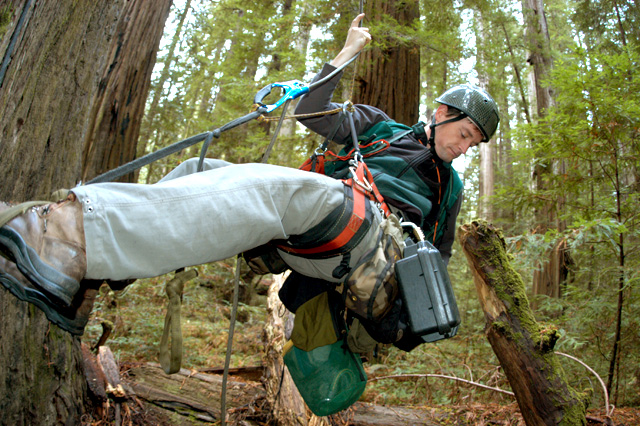
Sillett and his colleagues quantified crown structure and growth of coast redwood trees (Sequoia sempervirens) in Humboldt Redwoods State Park and mountain ash trees (Eucalyptus regnans) in Kinglake National Park in Australia.
Sillett is an acknowledged pioneer in the scientific study of redwoods and other tall trees, and he holds the Kenneth L. Fisher Chair in Redwood Forest Ecology at HSU.
“Annual above-ground wood production increased with size and age, up to and including the largest and oldest trees we measured,” Sillett and his colleagues write in an article titled “Increasing Wood Production Through Old Age in Tall Trees.” It appears in a recent issue of Forest Ecology and Management, an international peer-reviewed journal.
Sillett climbed and directly measured crown structures and growth rates of 43 trees representing a wide range of sizes and ages. He was joined by Robert Van Pelt (HSU Department of Forestry and Wildland Resources), George W. Koch (Department of Biological Sciences and the Merriam-Powell Center for Environmental Research at Northern Arizona University-Flagstaff), Anthony R. Ambrose (Department of Integrative Biology at UC Berkeley), Allyson L. Carroll (HSU Department of Forestry and Wildland Resources), Marie E. Antoine (HSU Department of Forestry and Wildland Resources), and Brett M. Mifsud (Sherbrooke, Victoria, Australia).
Sillett’s group compared the two tallest species to evaluate how biophysical and ecological factors interact to determine trees’ growth rates as they approach maximize size. To surmount the limitations of ground-based measurements, the team climbed trees during consecutive years and directly measured a complete inventory of crown elements.
Trees were rigged and climbed using rope techniques. A fiberglass measuring tape was fastened near the treetop and lowered to an average ground level, furnishing a height reference for all measurements. “The resulting three-dimensional maps of above-ground structure allowed quantification of whole-tree biomass and annual growth,” they write.
To avoid overestimating bark, sapwood, and heartwood volumes in non-round sections of the lower trunk—which can extend up to 20 meters above the ground—detailed cross-sections of the non-round portions of each tree were made with laser-based triangulation. Bark and sapwood thicknesses for portions larger than branches were obtained by increment coring. Cores were sampled near the tree base above buttressing near the ground, just below the base of the live crown, and near treetop on the main trunk. Some additional cores were collected at intermediate heights and from appendages. Annual wood growth was calculated by subtracting volumes based on measurements made in 2005 from those made in 2006.
The authors noted that an eventual decline in tree growth is a theoretical certainty, as no organism can live or grow forever. However, their study revealed that wood production of entire main trunks and whole crowns increased with age up to 300 years in mountain ash and 2,000 years in coast redwood, even though ground-level measurements of growth in trunk diameter and tree height confirmed the oft-reported phenomenon of declining growth with age.
Sillett and his colleagues emphasize that although a great deal of scientific effort has been devoted to the causes of post-maturity decline, the distinction is often blurred between factors operating at the tree- versus the stand-level.
“Barring catastrophic damage from fire or falling, our results indicate that non-suppressed trees of both species enlarge steadily and maintain high leaf area well into old age, even after height growth has nearly ceased,” the researchers concluded.
How long tree growth can be sustained with increasing age remains an open question, the authors said, primarily because past research has relied too heavily on ground-based measurements and on felled trees, whose crowns were largely destroyed after falling. Direct measurements of important crown components, including branches and leaves, are necessary to quantify the structure and growth of tall trees.
Sillett’s team is now extending its work to the stand-level in forests throughout the geographic ranges of coast redwood and its closest living relative, giant sequoia.
For more information about Steve Sillett and other researchers at the HSU Institute for Redwood Ecology, visit www.humboldt.edu/redwoods.